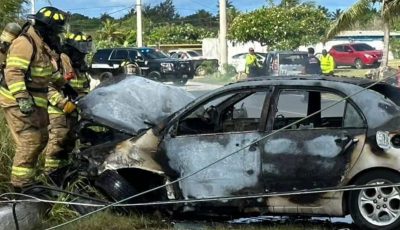Five things about used cars
First, the bad news: I didn’t hit the lotto this year. Therefore, delivery of the new M-class Mercedes I deserve has been thwarted by the wiles of Lady Luck. As for the good news, I’ve finally pulled together some notes on how to find a good used car. I’ve found some good buys in my time, and I’ve finally realized that being prepared is the best way to hit the jackpot.
This preparation has come in two steps: I’ve scribed a written checklist for buying a car, and I’ve assembled a handy little tool kit for making pre-purchase inspections. Yeah, I was bored when I did this, so it soaked up an otherwise idle weekend.
I’m not claiming to be an expert here. I’m not an expert. But I like cars and I have found that having some method is better than having no method at all.
Here’s my big concept, and Saipan’s thin market emphasizes the fact: You don’t want to be in a position where you have to buy a car “right now.” The used market is incredibly imperfect, so we’re either on top of it, or under it.
Today, I’m going to take a general look at this gig. Lots of this stuff deserves more detailed attention, so I’m trying to organize things along those lines for future screeds.
Anyway, the first chunk of my checklist itemizes my humble little car-evaluation tool bag. Here it is: (1) A bright LED flashlight, (2) a cigar-lighter voltage checker, (3) an amateur-grade diagnostic computer code reader, (4) an air conditioning duct thermometer, and (5) a rag. This is probably self-explanatory, but maybe I’ll flesh in some explanation in the future.
Here’s how my list organizes the process:
1). Seller conversation
The first thing I want to know is whether the seller is a liar. And the first thing I ask is if the vehicle has any history of accidents, damage, or re-painting. Like a good lawyer or a savvy cop, I often know the answer before I ask the question.
During this conversation I am totally focused on the seller. I’m not talking over-the-shoulder as I look over the car. I’m not inspecting the car yet. I’m inspecting the seller.
If I sense anything hinky, I just politely go away. After all, I don’t need the car. Therefore, I can choose who I deal with. That’s the whole idea here, remember?
2). The car inspection
Most of my list is an item-by-item checklist for the actual mechanical inspection.
I’ll spare you the details since I’m taking a general swipe at things today, but in the future I may share a few items that are easy to forget but which I’ve found to be really important.
One such item saved me from making a big mistake today, which is what inspired this article. But, for now, the point is that any method is better than no method.
As I look over a car, I have learned to write down any discrepancies instead of trying to remember them. Even a really nice car might have a dozen items worth noting. The time to ponder the importance of the items is later on, after the inspection is done. Also, I found that having written notes makes things easier when negotiating with the seller since it puts things on a more objective basis.
3). Documents
As a small and isolated market, Saipan is subject to its own dynamics. But if you’re moving stateside, and many people do, then you’ll want to note a few resources. CarFax.com offers written reports that can uncover issues in a vehicle history (e.g. accidents); this isn’t perfect or ironclad, but it is useful. And Edmunds.com offers free data on market prices.
4). Professional inspection
I know good mechanics who charge under $100 for a basic inspection, so it’s a good deal.
5). Final negotiation
I don’t know why people worry about this so much. From my experience, if I’ve done my homework, if I’m dealing with a seller who is sane, reasonable, and not sleazy, and if I’ve noted, in writing, the items that determine the vehicle’s condition (as mentioned above), then the price seems to be easy to agree on. Then again, I’m not a haggler, a low-ball tosser, or a hard negotiator.
The sellers I’ve dealt with were the types of people who took very good care of their cars. They were not out to spend hours upon hours entertaining random strangers just to try to milk every last dime out of the sale.
By contrast, the bottom-feeders are part of a different eco-system, and I have no desire to be part of that swamp, either as a buyer or a seller.
Visit Ed Stephens Jr. at EdStephensJr.com. His column runs every Friday.





















